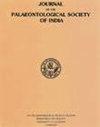Using proxy data and vegetation modelling to predict past, current and future distributional shifts of Butea monosperma, a marker of land degradation in India
IF 0.5
4区 地球科学
Q4 PALEONTOLOGY
Journal of the Palaeontological Society of India
Pub Date : 2024-05-21
DOI:10.1177/05529360241240092
引用次数: 0
Abstract
Extensive deviations in spatio-temporal social and environmental dynamics currently alter the health of ecosystems and the services they provide. Detecting the causes that contribute to the distribution of a natural forest species capable of restoring the lost ecosystem function and productivity will aid in determining better food security, livelihoods and provision of ecosystem goods and services. We modelled the spatial range of Butea monosperma (B. monosperma) under past, that is, Last Glacial Maximum (LGM), Middle Holocene (MH), current and future (2070) climatic scenarios with Maximum Entropy (MaxEnt) trained on present-day occurrences. We identified areas of suitable habitats for which the estimation of habitat stability is predicted in all the models at different times. To validate the inferred suitable habitat, we tested the model by the current occurrence and fossil pollen data of B. monosperma. Our distribution models agree with the fossil pollen records for the MH (4,500–7,000 yr BP) and predict the prevalence of B. monosperma covering 84.22% of the Indian subcontinent with maximum habitat stability in western and southwestern India (10.95%). The widespread potential distribution of the plant species during the LGM supports the presence of the last remnants of tropical dry deciduous forest in the region. However, a decline in habitat suitability (62.84%) is predicted under current and future climatic scenarios with maximum stability (0.90%–3.09%) along the Western Ghats, Nilgiri hills, Gir range in the western India and north-eastern region covering the Assam Valley and foothills of Tripura and Mizo hills. Temperature seasonality (33.6%) measured in terms of variable contribution in MaxEnt model significantly affects the distribution shift of B. monosperma, along with annual precipitation (22.8%) and annual mean temperature (16.2%). Model results provide evidence of habitat reduction and identify the stability hotspots for B. monosperma for its conservation and establishment of land management policies mainly for the dry tropics.利用代用数据和植被建模预测印度土地退化的标志--箭毒树过去、现在和未来的分布变化
目前,社会和环境动态时空的广泛偏差改变了生态系统的健康及其提供的服务。检测导致能够恢复丧失的生态系统功能和生产力的天然林物种分布的原因,将有助于确定更好的粮食安全、生计以及生态系统产品和服务的提供。我们利用最大熵(MaxEnt)模拟了箭毒树(Butea monosperma)在过去,即末次冰川极盛时期(LGM)、全新世中期(MH)、当前和未来(2070 年)气候情景下的空间分布。我们确定了适合栖息的区域,所有模型都能预测这些区域在不同时期的栖息地稳定性。为了验证推断的适宜栖息地,我们用单冠花蝶的现今分布和化石花粉数据对模型进行了测试。我们的分布模型与 MH(公元前 4,500-7,000 年)的花粉化石记录一致,并预测独脚金花蟾的分布将覆盖印度次大陆 84.22% 的地区,其中印度西部和西南部的栖息地稳定性最高(10.95%)。该植物物种在远古时期的广泛潜在分布支持了该地区热带干燥落叶林最后遗迹的存在。然而,在当前和未来的气候情景下,栖息地适宜性预计将下降(62.84%),最大稳定性(0.90%-3.09%)沿西高止山脉、尼尔吉里丘陵、印度西部的吉尔山脉以及东北部地区(包括阿萨姆河谷、特里普拉邦山麓和米佐山丘)。在 MaxEnt 模型中,以变量贡献率衡量的温度季节性(33.6%)与年降水量(22.8%)和年平均气温(16.2%)一起,对单叶榕的分布变化产生了重大影响。模型结果提供了栖息地减少的证据,并确定了猴面包树的稳定热点,有助于保护猴面包树和制定主要针对干旱热带地区的土地管理政策。
本文章由计算机程序翻译,如有差异,请以英文原文为准。
求助全文
约1分钟内获得全文
求助全文
来源期刊

Journal of the Palaeontological Society of India
PALEONTOLOGY-
CiteScore
1.10
自引率
16.70%
发文量
0
期刊介绍:
The journal is devoted to the publication of original papers and review articles dealing with all aspects of Paleontology, Paleobotany, Stratigraphy, Geochronology, Anthropology and Pre-history.
 求助内容:
求助内容: 应助结果提醒方式:
应助结果提醒方式:


